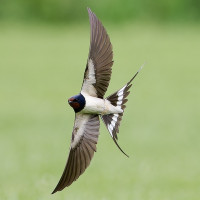Beschreibung
The 375 ha large wetland reserve Schlammwiss in Uebersyren is an important migratory stopover for a great amount of birds, which use the wetlands to refill their reserves. The area has marshes, patches of forest, agricultural lands and orchards and Schlammwiss has with almost 20 hectares one of the biggest reed banks in Luxembourg.
The main bird species using the reed banks are Teichrohrsänger, Sumpfrohrsänger and Rohrammer. Beside the breeding birds the reed banks are a stopover place for Blaukehlchen, Beutelmeise, Bartmeise, Rohrschwirl, Drosselrohrsänger, Schilfrohrsänger and Seggenrohrsänger. In the open areas between the reedbeds and the surrounding farms you can find birds like Schwarzkehlchen, Neuntöter, Stieglitz, Dorngrasmücke and Feldschwirl and during migration Wachtel, Braunkehlchen and Steinschmätzer.
About 40.000 Rauchschwalbe with Uferschwalbe arrive every year around August-September in the reed banks of Schlammwiss and create a natural spectacle that attracts predators like Baumfalke, Wanderfalke, Sperber and some owls. Futhermore big groups of Star - about 20.000 each year - and Bergpieper – about 100 each year – are using the reeds as sleeping or over wintering place too. As well small groups of Bachstelze, Wiesenschafstelze and Goldammer are using the reed as sleeping place.
Details
Zugang
Park in the village and explore on foot. There is also a bird ringing station allowing important research and studies about biodiversity and nature conservation. The bird-ringing station Uebersyren offers guided tours, see the link below.



